Abstract
The etiology of alopecia areata (AA), a putative autoimmune disease characterized by sudden hair loss, has remained obscure. It is not understood, how the characteristic inflammatory infiltrate that selectively attacks anagen hair follicles in AA is generated. We hypothesize that this reflects an unexplored form of autoimmunity, a cytotoxic T cell attack on rhythmically synthesized autoantigens normally sequestered by a lack or very low level of MHC class I (MHC I)-expression, and suggest the following mechanism of AA pathogenesis: Microtrauma, neurogenic inflammation, or microbial antigens cause a localized breakdown of MHC I-"negativity" in the proximal anagen hair bulb via proinflammatory cytokines. This exposes autoantigens derived from melanogenesis-related proteins (MRP-DP), which are only generated during anagen, and triggers two successive waves of autoimmune responses: CD8+ cytotoxic T cells initiate AA after recognizing MRP-DP abnormally presented by MHC I molecules on hair matrix melanocytes and/or keratinocytes; a secondary attack, carried by CD4+ T cells and antigen presenting cells, is then mounted against MHC class II--presented additional autoantigens exposed by damaged melanocytes and keratinocytes. The latter causes most of the follicular damage, and extrafollicular disease, and depends greatly on the immunogenetic background of affected individuals. This unifying hypothesis explains the clinical heterogeneity and all salient features of AA, and argues that only the unlikely coincidence of multiple predisposing events triggers AA. The suppression of MHC I--expression and synthesis of MRP in the hair bulb, and the "tolerization" of MRP-DP autoreactive CD8+ T cells may be promising strategies for treating AA.
Full text
PDF

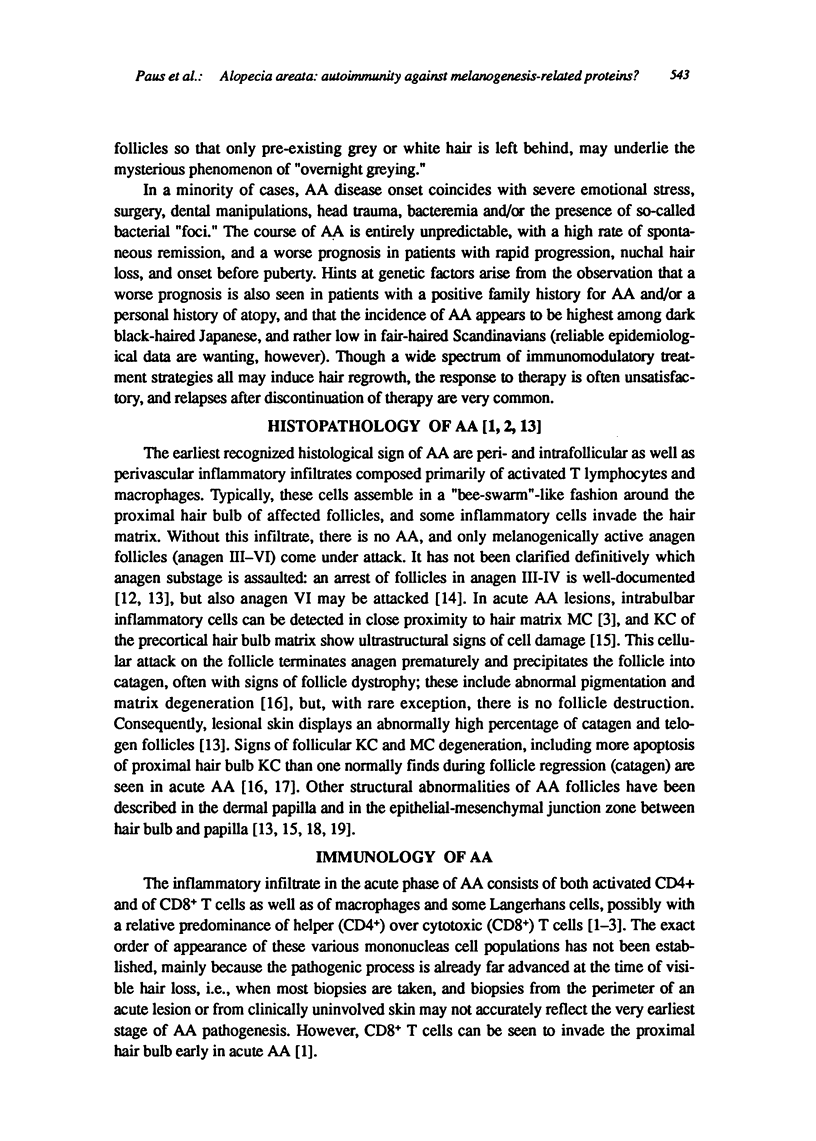


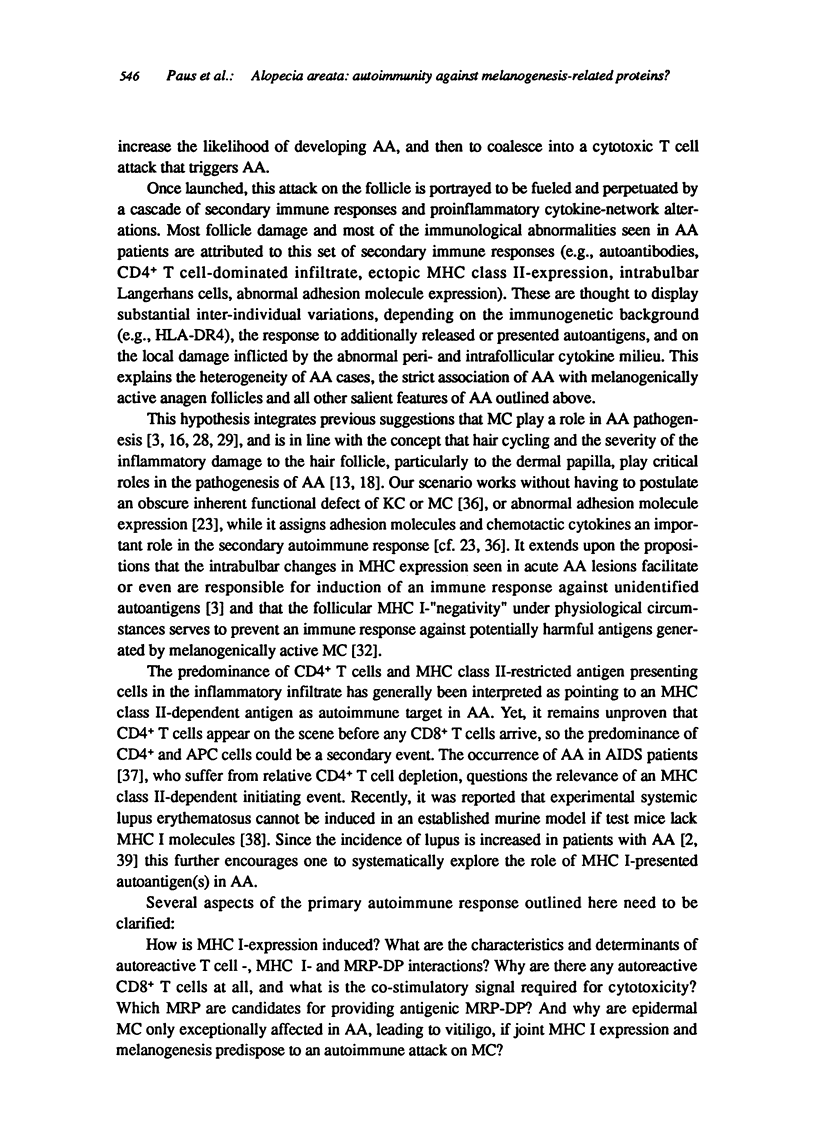



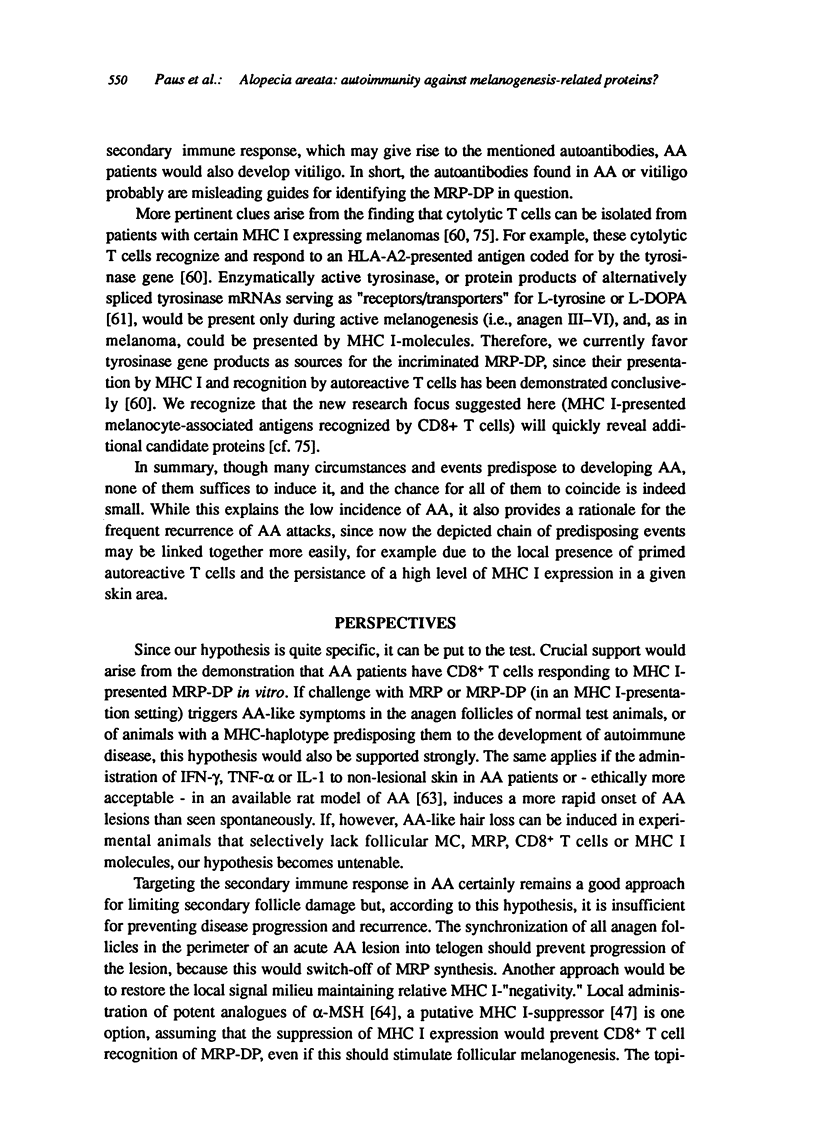
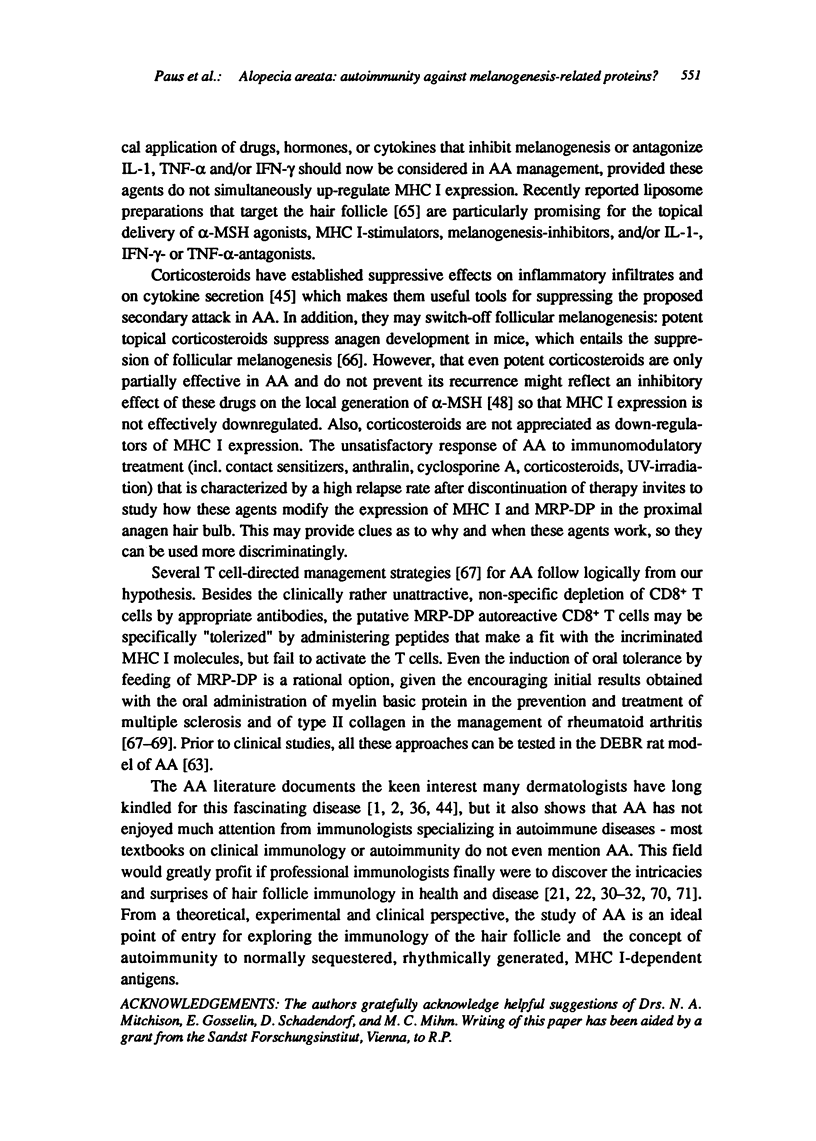


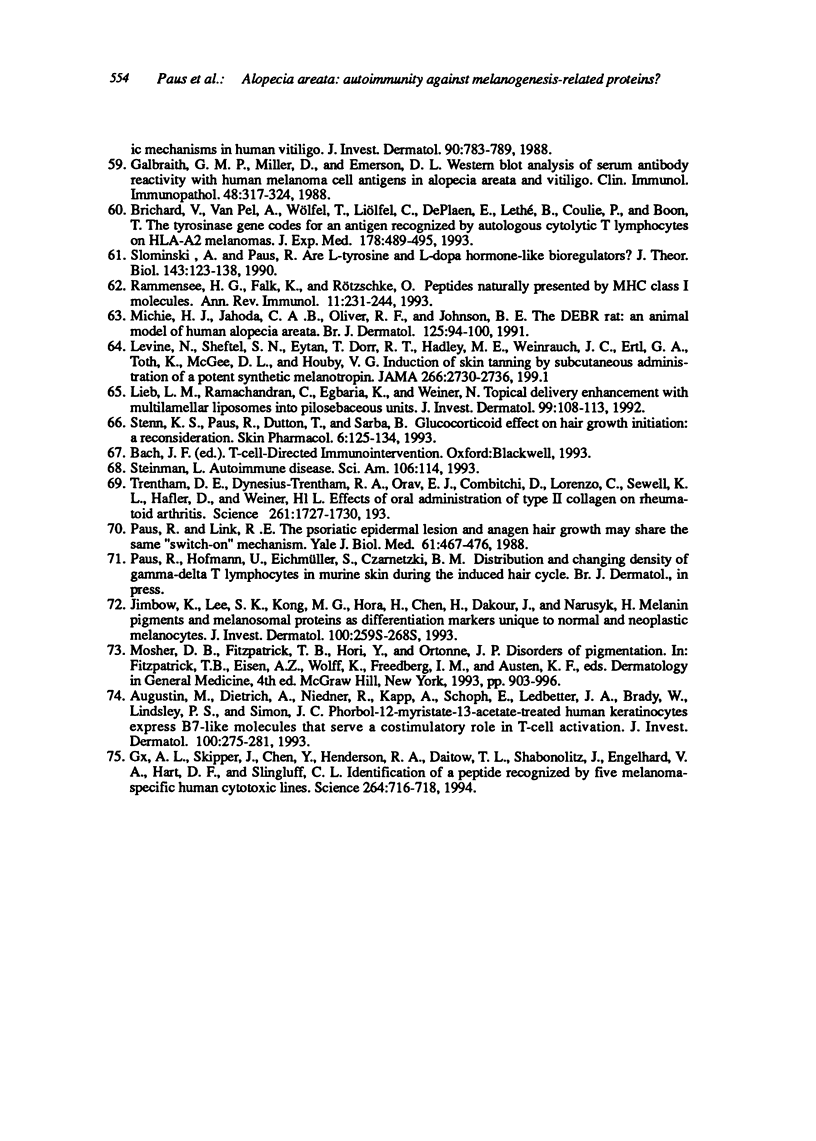
Selected References
These references are in PubMed. This may not be the complete list of references from this article.
- Augustin M., Dietrich A., Niedner R., Kapp A., Schöpf E., Ledbetter J. A., Brady W., Linsley P. S., Simon J. C. Phorbol-12-myristate-13-acetate-treated human keratinocytes express B7-like molecules that serve a costimulatory role in T-cell activation. J Invest Dermatol. 1993 Mar;100(3):275–281. doi: 10.1111/1523-1747.ep12469748. [DOI] [PubMed] [Google Scholar]
- Billingham R. E., Silvers W. K. A biologist's reflections on dermatology. J Invest Dermatol. 1971 Oct;57(4):227–240. doi: 10.1111/1523-1747.ep12261543. [DOI] [PubMed] [Google Scholar]
- Bos J. D., Kapsenberg M. L. The skin immune system: progress in cutaneous biology. Immunol Today. 1993 Feb;14(2):75–78. doi: 10.1016/0167-5699(93)90062-P. [DOI] [PubMed] [Google Scholar]
- Brain S. D., Williams T. J. Neuropharmacology of peptides in skin. Semin Dermatol. 1988 Dec;7(4):278–283. [PubMed] [Google Scholar]
- Brichard V., Van Pel A., Wölfel T., Wölfel C., De Plaen E., Lethé B., Coulie P., Boon T. The tyrosinase gene codes for an antigen recognized by autologous cytolytic T lymphocytes on HLA-A2 melanomas. J Exp Med. 1993 Aug 1;178(2):489–495. doi: 10.1084/jem.178.2.489. [DOI] [PMC free article] [PubMed] [Google Scholar]
- Bröcker E. B., Echternacht-Happle K., Hamm H., Happle R. Abnormal expression of class I and class II major histocompatibility antigens in alopecia areata: modulation by topical immunotherapy. J Invest Dermatol. 1987 May;88(5):564–568. doi: 10.1111/1523-1747.ep12470166. [DOI] [PubMed] [Google Scholar]
- Bystryn J. C., Tamesis J. Immunologic aspects of hair loss. J Invest Dermatol. 1991 May;96(5):88S–89S. doi: 10.1111/1523-1747.ep12858178. [DOI] [PubMed] [Google Scholar]
- Cox A. L., Skipper J., Chen Y., Henderson R. A., Darrow T. L., Shabanowitz J., Engelhard V. H., Hunt D. F., Slingluff C. L., Jr Identification of a peptide recognized by five melanoma-specific human cytotoxic T cell lines. Science. 1994 Apr 29;264(5159):716–719. doi: 10.1126/science.7513441. [DOI] [PubMed] [Google Scholar]
- Cui J., Arita Y., Bystryn J. C. Cytolytic antibodies to melanocytes in vitiligo. J Invest Dermatol. 1993 Jun;100(6):812–815. doi: 10.1111/1523-1747.ep12476636. [DOI] [PubMed] [Google Scholar]
- Cui J., Harning R., Henn M., Bystryn J. C. Identification of pigment cell antigens defined by vitiligo antibodies. J Invest Dermatol. 1992 Feb;98(2):162–165. doi: 10.1111/1523-1747.ep12555773. [DOI] [PubMed] [Google Scholar]
- Duvic M., Hordinsky M. K., Fiedler V. C., O'Brien W. R., Young R., Reveille J. D. HLA-D locus associations in alopecia areata. DRw52a may confer disease resistance. Arch Dermatol. 1991 Jan;127(1):64–68. [PubMed] [Google Scholar]
- Galbraith G. M., Miller D., Emerson D. L. Western blot analysis of serum antibody reactivity with human melanoma cell antigens in alopecia areata and vitiligo. Clin Immunol Immunopathol. 1988 Sep;48(3):317–324. doi: 10.1016/0090-1229(88)90025-6. [DOI] [PubMed] [Google Scholar]
- Gilhar A., Pillar T., Assay B., David M. Failure of passive transfer of serum from patients with alopecia areata and alopecia universalis to inhibit hair growth in transplants of human scalp skin grafted on to nude mice. Br J Dermatol. 1992 Feb;126(2):166–171. doi: 10.1111/j.1365-2133.1992.tb07815.x. [DOI] [PubMed] [Google Scholar]
- Goldsmith L. A. Summary of alopecia areata research workshop and future research directions. J Invest Dermatol. 1991 May;96(5):98S–100S. doi: 10.1111/1523-1747.ep12472257. [DOI] [PubMed] [Google Scholar]
- Harrist T. J., Ruiter D. J., Mihm M. C., Jr, Bhan A. K. Distribution of major histocompatibility antigens in normal skin. Br J Dermatol. 1983 Dec;109(6):623–633. doi: 10.1111/j.1365-2133.1983.tb00540.x. [DOI] [PubMed] [Google Scholar]
- Hull S. M., Nutbrown M., Pepall L., Thornton M. J., Randall V. A., Cunliffe W. J. Immunohistologic and ultrastructural comparison of the dermal papilla and hair follicle bulb from "active" and "normal" areas of alopecia areata. J Invest Dermatol. 1991 May;96(5):673–681. doi: 10.1111/1523-1747.ep12470601. [DOI] [PubMed] [Google Scholar]
- Janeway C. A., Jr How the immune system recognizes invaders. Sci Am. 1993 Sep;269(3):72–79. doi: 10.1038/scientificamerican0993-72. [DOI] [PubMed] [Google Scholar]
- Jimbow K., Lee S. K., King M. G., Hara H., Chen H., Dakour J., Marusyk H. Melanin pigments and melanosomal proteins as differentiation markers unique to normal and neoplastic melanocytes. J Invest Dermatol. 1993 Mar;100(3):259S–268S. doi: 10.1111/1523-1747.ep12470103. [DOI] [PubMed] [Google Scholar]
- Kalish R. S., Johnson K. L., Hordinsky M. K. Alopecia areata. Autoreactive T cells are variably enriched in scalp lesions relative to peripheral blood. Arch Dermatol. 1992 Aug;128(8):1072–1077. doi: 10.1001/archderm.128.8.1072. [DOI] [PubMed] [Google Scholar]
- Khoury E. L., Price V. H., Greenspan J. S. HLA-DR expression by hair follicle keratinocytes in alopecia areata: evidence that it is secondary to the lymphoid infiltration. J Invest Dermatol. 1988 Feb;90(2):193–200. doi: 10.1111/1523-1747.ep12462213. [DOI] [PubMed] [Google Scholar]
- Kwon B. S. Pigmentation genes: the tyrosinase gene family and the pmel 17 gene family. J Invest Dermatol. 1993 Feb;100(2 Suppl):134S–140S. doi: 10.1111/1523-1747.ep12465022. [DOI] [PubMed] [Google Scholar]
- Lieb L. M., Ramachandran C., Egbaria K., Weiner N. Topical delivery enhancement with multilamellar liposomes into pilosebaceous units: I. In vitro evaluation using fluorescent techniques with the hamster ear model. J Invest Dermatol. 1992 Jul;99(1):108–113. doi: 10.1111/1523-1747.ep12611886. [DOI] [PubMed] [Google Scholar]
- McDonagh A. J., Cawood L., Messenger A. G. Expression of extracellular matrix in hair follicle mesenchyme in alopecia areata. Br J Dermatol. 1990 Dec;123(6):717–724. doi: 10.1111/j.1365-2133.1990.tb04188.x. [DOI] [PubMed] [Google Scholar]
- Mcdonagh A. J., Snowden J. A., Stierle C., Elliott K., Messenger A. G. HLA and ICAM-1 expression in alopecia areata in vivo and in vitro: the role of cytokines. Br J Dermatol. 1993 Sep;129(3):250–256. doi: 10.1111/j.1365-2133.1993.tb11842.x. [DOI] [PubMed] [Google Scholar]
- Messenger A. G., Bleehen S. S. Alopecia areata: light and electron microscopic pathology of the regrowing white hair. Br J Dermatol. 1984 Feb;110(2):155–162. doi: 10.1111/j.1365-2133.1984.tb07461.x. [DOI] [PubMed] [Google Scholar]
- Messenger A. G., Bleehen S. S. Expression of HLA-DR by anagen hair follicles in alopecia areata. J Invest Dermatol. 1985 Dec;85(6):569–572. doi: 10.1111/1523-1747.ep12277414. [DOI] [PubMed] [Google Scholar]
- Messenger A. G., Slater D. N., Bleehen S. S. Alopecia areata: alterations in the hair growth cycle and correlation with the follicular pathology. Br J Dermatol. 1986 Mar;114(3):337–347. doi: 10.1111/j.1365-2133.1986.tb02825.x. [DOI] [PubMed] [Google Scholar]
- Michie H. J., Jahoda C. A., Oliver R. F., Johnson B. E. The DEBR rat: an animal model of human alopecia areata. Br J Dermatol. 1991 Aug;125(2):94–100. doi: 10.1111/j.1365-2133.1991.tb06054.x. [DOI] [PubMed] [Google Scholar]
- Mozes E., Kohn L. D., Hakim F., Singer D. S. Resistance of MHC class I-deficient mice to experimental systemic lupus erythematosus. Science. 1993 Jul 2;261(5117):91–93. doi: 10.1126/science.8316860. [DOI] [PubMed] [Google Scholar]
- Nickoloff B. J., Griffiths C. E. Aberrant intercellular adhesion molecule-1 (ICAM-1) expression by hair-follicle epithelial cells and endothelial leukocyte adhesion molecule-1 (ELAM-1) by vascular cells are important adhesion-molecule alterations in alopecia areata. J Invest Dermatol. 1991 May;96(5):91S–92S. doi: 10.1111/1523-1747.ep12472216. [DOI] [PubMed] [Google Scholar]
- Nickoloff B. J., Turka L. A. Keratinocytes: key immunocytes of the integument. Am J Pathol. 1993 Aug;143(2):325–331. [PMC free article] [PubMed] [Google Scholar]
- Norris D. A., Kissinger R. M., Naughton G. M., Bystryn J. C. Evidence for immunologic mechanisms in human vitiligo: patients' sera induce damage to human melanocytes in vitro by complement-mediated damage and antibody-dependent cellular cytotoxicity. J Invest Dermatol. 1988 Jun;90(6):783–789. doi: 10.1111/1523-1747.ep12461505. [DOI] [PubMed] [Google Scholar]
- Paus R., Link R. E. The psoriatic epidermal lesion and anagen hair growth may share the same "switch-on" mechanism. Yale J Biol Med. 1988 Sep-Oct;61(5):467–476. [PMC free article] [PubMed] [Google Scholar]
- Payan D. G. Neuropeptides and inflammation: the role of substance P. Annu Rev Med. 1989;40:341–352. doi: 10.1146/annurev.me.40.020189.002013. [DOI] [PubMed] [Google Scholar]
- Prose N. S., Abson K. G., Scher R. K. Disorders of the nails and hair associated with human immunodeficiency virus infection. Int J Dermatol. 1992 Jul;31(7):453–457. doi: 10.1111/j.1365-4362.1992.tb02688.x. [DOI] [PubMed] [Google Scholar]
- Rammensee H. G., Falk K., Rötzschke O. Peptides naturally presented by MHC class I molecules. Annu Rev Immunol. 1993;11:213–244. doi: 10.1146/annurev.iy.11.040193.001241. [DOI] [PubMed] [Google Scholar]
- Rebora A. Alopecia areata incognita: a hypothesis. Dermatologica. 1987;174(5):214–218. doi: 10.1159/000249182. [DOI] [PubMed] [Google Scholar]
- Rose N. R., Bona C. Defining criteria for autoimmune diseases (Witebsky's postulates revisited) Immunol Today. 1993 Sep;14(9):426–430. doi: 10.1016/0167-5699(93)90244-F. [DOI] [PubMed] [Google Scholar]
- Schwartz R. H. Costimulation of T lymphocytes: the role of CD28, CTLA-4, and B7/BB1 in interleukin-2 production and immunotherapy. Cell. 1992 Dec 24;71(7):1065–1068. doi: 10.1016/s0092-8674(05)80055-8. [DOI] [PubMed] [Google Scholar]
- Sherman L. A., Chattopadhyay S. The molecular basis of allorecognition. Annu Rev Immunol. 1993;11:385–402. doi: 10.1146/annurev.iy.11.040193.002125. [DOI] [PubMed] [Google Scholar]
- Slominski A., Paus R. Are L-tyrosine and L-dopa hormone-like bioregulators? J Theor Biol. 1990 Mar 8;143(1):123–138. doi: 10.1016/s0022-5193(05)80292-9. [DOI] [PubMed] [Google Scholar]
- Slominski A., Paus R., Costantino R. Differential expression and activity of melanogenesis-related proteins during induced hair growth in mice. J Invest Dermatol. 1991 Feb;96(2):172–179. doi: 10.1111/1523-1747.ep12460956. [DOI] [PubMed] [Google Scholar]
- Slominski A., Paus R. Melanogenesis is coupled to murine anagen: toward new concepts for the role of melanocytes and the regulation of melanogenesis in hair growth. J Invest Dermatol. 1993 Jul;101(1 Suppl):90S–97S. doi: 10.1111/1523-1747.ep12362991. [DOI] [PubMed] [Google Scholar]
- Slominski A., Paus R., Schadendorf D. Melanocytes as "sensory" and regulatory cells in the epidermis. J Theor Biol. 1993 Sep 7;164(1):103–120. doi: 10.1006/jtbi.1993.1142. [DOI] [PubMed] [Google Scholar]
- Slominski A., Paus R., Wortsman J. On the potential role of proopiomelanocortin in skin physiology and pathology. Mol Cell Endocrinol. 1993 May;93(1):C1–C6. doi: 10.1016/0303-7207(93)90131-3. [DOI] [PubMed] [Google Scholar]
- Steinman L. Autoimmune disease. Sci Am. 1993 Sep;269(3):106–114. doi: 10.1038/scientificamerican0993-106. [DOI] [PubMed] [Google Scholar]
- Stenn K. S., Paus R., Dutton T., Sarba B. Glucocorticoid effect on hair growth initiation: a reconsideration. Skin Pharmacol. 1993;6(2):125–134. doi: 10.1159/000211097. [DOI] [PubMed] [Google Scholar]
- Tatake R. J., Zeff R. A. Regulated expression of the major histocompatibility complex class I genes. Proc Soc Exp Biol Med. 1993 Sep;203(4):405–417. doi: 10.3181/00379727-203-43616a. [DOI] [PubMed] [Google Scholar]
- Tobin D. J., Fenton D. A., Kendall M. D. Cell degeneration in alopecia areata. An ultrastructural study. Am J Dermatopathol. 1991 Jun;13(3):248–256. doi: 10.1097/00000372-199106000-00006. [DOI] [PubMed] [Google Scholar]
- Tobin D. J., Fenton D. A., Kendall M. D. Ultrastructural observations on the hair bulb melanocytes and melanosomes in acute alopecia areata. J Invest Dermatol. 1990 Jun;94(6):803–807. doi: 10.1111/1523-1747.ep12874660. [DOI] [PubMed] [Google Scholar]
- Tosti A. Alopecia areata: more on pathogenesis and therapy. Dermatologica. 1989;178(2):61–63. doi: 10.1159/000248392. [DOI] [PubMed] [Google Scholar]
- Tsukamoto K., Jackson I. J., Urabe K., Montague P. M., Hearing V. J. A second tyrosinase-related protein, TRP-2, is a melanogenic enzyme termed DOPAchrome tautomerase. EMBO J. 1992 Feb;11(2):519–526. doi: 10.1002/j.1460-2075.1992.tb05082.x. [DOI] [PMC free article] [PubMed] [Google Scholar]
- Werth V. P., White W. L., Sanchez M. R., Franks A. G. Incidence of alopecia areata in lupus erythematosus. Arch Dermatol. 1992 Mar;128(3):368–371. [PubMed] [Google Scholar]
- Westgate G. E., Craggs R. I., Gibson W. T. Immune privilege in hair growth. J Invest Dermatol. 1991 Sep;97(3):417–420. doi: 10.1111/1523-1747.ep12481002. [DOI] [PubMed] [Google Scholar]
- Zhang L., Weetman A. P., Friedmann P. S., Oliveira D. B. HLA associations with alopecia areata. Tissue Antigens. 1991 Aug;38(2):89–91. doi: 10.1111/j.1399-0039.1991.tb01885.x. [DOI] [PubMed] [Google Scholar]


